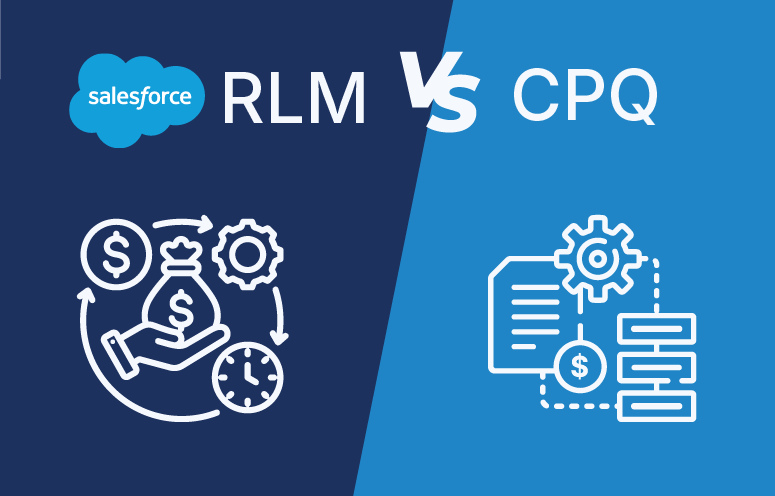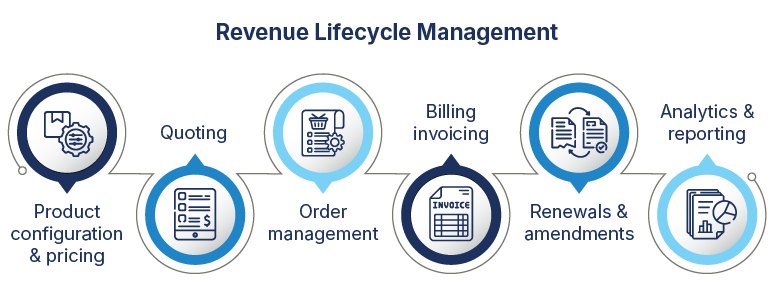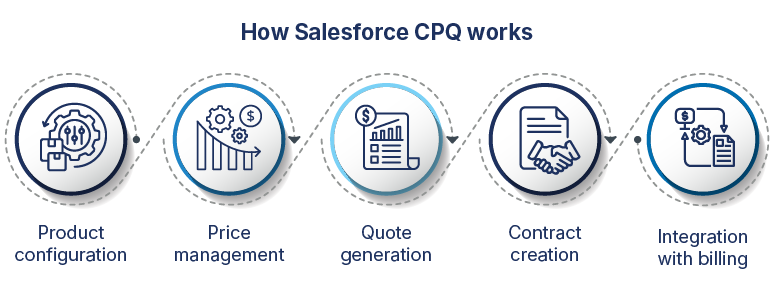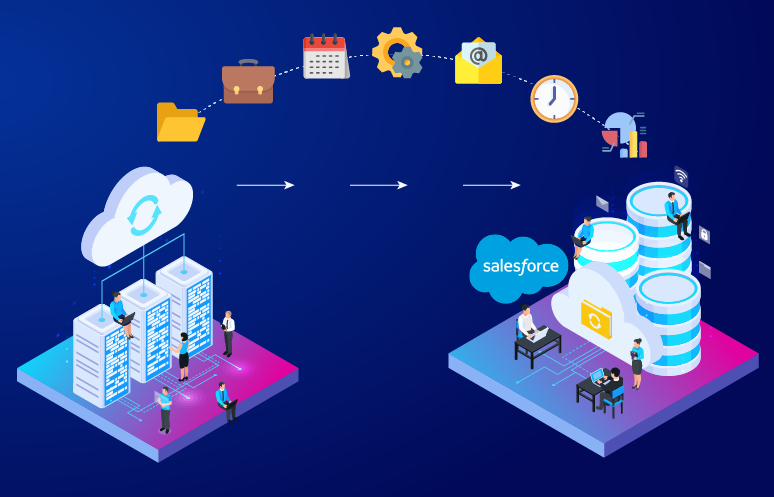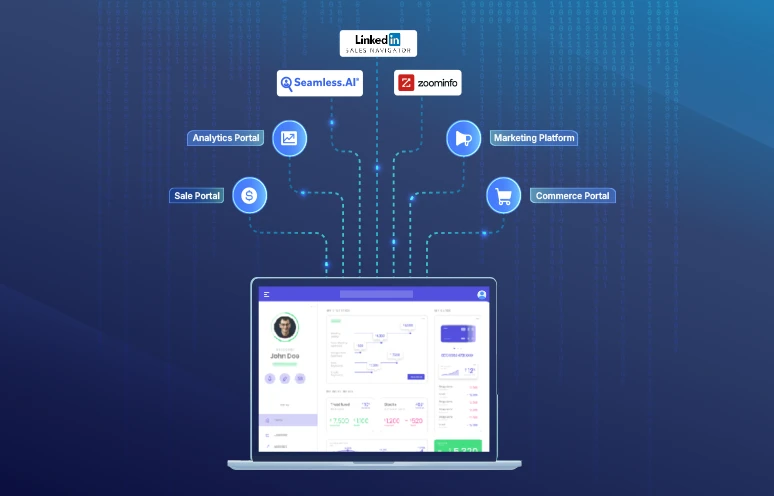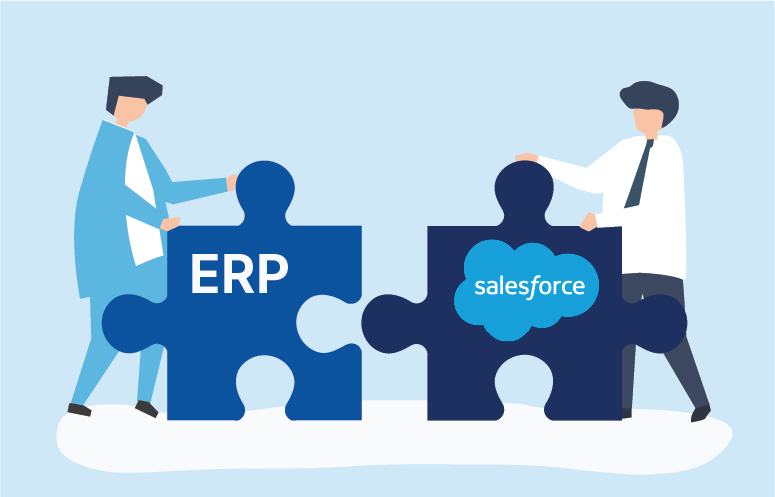Salesforce Revenue Cloud promises a seamless quote-to-cash pipeline, yet quarter-close can still feel slow and fragmented. Gartner observes that many companies juggle ten or more separate systems just to move a deal from lead to renewal, and every extra hand-off invites delays and data slips. As pricing models shift and compliance rules keep changing, finance teams frequently invest extensive time reconciling financial discrepancies that ideally should have aligned from the outset.
Organizations that roll out a modern Configure-Price-Quote (CPQ) layer cut quote-generation time by as much as 40 percent and trim errors by roughly 25 percent.
– JISEM Journal
Those gains are real, but momentum fades once invoices, revenue schedules, and renewals move beyond CPQ’s reach. Salesforce Revenue Lifecycle Management (RLM) closes that gap by automating compliance checks, billing runs, and renewal prompts, ensuring revenue data stays clean and audit ready.
A specialised Salesforce partner can trace the weak links in your current stack, measure revenue leakage, and craft a phased plan that modernises quote-to-cash without disturbing cash flow. This article reviews the core strengths of CPQ and RLM, compares their benefits side by side, and offers a clear decision framework to help you choose the route that delivers sustained, compliant growth.
What is Salesforce RLM?
Salesforce RLM, or Revenue Lifecycle Management, is the part of Revenue Cloud that takes over once a deal is signed. It gathers billing schedules, revenue-recognition rules and renewal dates inside the same record sales teams already use for quotes and orders. Finance can manage subscription plans or usage tiers through a unified console, where the system automates invoicing, enforces correct revenue recognition, and tracks contract renewal and compliance dates.
Standards such as ASC 606 (Revenue from Contracts with Customers) and IFRS 15 (International guidelines for revenue recognition) leave little room for error as they require strict, consistent methods for recognizing revenue across all contract types. By letting software handle the calculations, RLM keeps the ledger tidy and ready for audit while surfacing renewal opportunities before they slip away. Teams close the books faster, report figures with confidence and give customers a smoother billing experience. The process eliminates the need for fragmented spreadsheets and isolated solutions that typically weigh down finance operations.
What is Salesforce CPQ?
Salesforce CPQ (Configure, Price, Quote) is the native quoting engine within Sales Cloud. It lets sales teams build accurate proposals directly from the opportunity record, applying the correct price books, discount rules, and contract terms in a single workflow. Pricing rules, volume discounts and contract terms apply automatically as items are added to the opportunity.
Guided-selling flows recommend the right bundles and services, and approval processes forward nonstandard deals to managers for review. Once a quote is finalised, the application generates a branded proposal ready for signature and converts it into an order in a single step. This approach cuts pricing errors, speeds up the sales cycle and gives leadership clear insight into pipeline progress.
What are the key differences between Salesforce CPQ and RLM
Evaluating the right solution for your revenue process means knowing which part of Salesforce Sales Cloud handles each stage. The table below highlights how CPQ’s pre-sale strengths align with RLM’s post-sale automation.
| Capability | Salesforce CPQ | Salesforce RLM |
|---|---|---|
| Product configuration | Offers rule-based guided selling to assemble valid bundles | Relies on configurations from Sales Cloud or CPQ; does not include configuration tools |
| Pricing and discount logic | Applies dynamic pricing rules, volume tiers and approvals | Enforces billing based on agreed rates; does not calculate pricing |
| Billing and invoicing | Generates quotes and proposals but not invoices | Automates invoice creation and delivery according to contract schedules |
| Revenue recognition compliance | Requires manual or third-party steps to post revenue | Calculates and posts revenue entries in line with ASC 606 and IFRS 15 standards |
| Renewal management | Supports renewal quotes via manual re-quote workflows | Triggers renewal alerts and manages amendment processes automatically |
Linking CPQ to RLM lets quotes flow straight into billing and recognition without manual hand-offs. Finance teams report fewer errors, faster invoice cycles and clearer sightlines on upcoming renewals. That tight integration turns every quote into predictable, audit-ready revenue.
What are the key features of Salesforce RLM?
Complex subscription models and compliance mandates put pressure on finance teams facing heavy workloads. Salesforce RLM addresses these needs through its core capabilities that automate and streamline critical revenue processes.
Automated billing cycles
After billing parameters are defined, Salesforce RLM assembles and issues invoices at the correct frequency, applies usage or tiered charges, and updates accounts receivable automatically. The workflow shortens, accelerates billing cycles, and improves cash predictability.
Invoice validation and error reduction
Built-in validation compares invoice details with product catalogue values, contractual terms, and pricing policies before release. The check stops mischarges, lowers the volume of credit notes, and accelerates payment cycles by reducing customer queries.
Automated revenue recognition
RLM creates deferred-revenue schedules automatically in compliance with ASC 606 and IFRS 15. This feature automatically posts journal entries on your behalf, eliminates manual calculations and keeps your financial statements audit ready.
Proactive renewal management
RLM links each contract to a renewal clock that alerts the account team weeks in advance. The extra lead time lets them confirm the next term with the client, secure steady recurring revenue, and avoid the added cost of restoring an expired account.
What are the benefits of Salesforce RLM
Salesforce RLM brings finance, operations, and customer-facing teams onto the same data foundation. The results show up quickly in billing speed, audit quality, and decision-making clarity.
-
Efficient billing cycles
Once the billing dates are set, Salesforce RLM handles the rest. Invoices reach customers on schedule, match contract terms, and land in inboxes while the details are still the latest. Finance teams face fewer follow-up questions and see cash arrive sooner.
-
Improved compliance
RLM applies ASC 606 and IFRS 15 rules as it posts revenue entries, producing a clear audit trail without manual calculations. Consistent treatment of contracts reduces the likelihood of post-close adjustments and helps auditors validate figures more quickly.
-
Enhanced visibility
Revenue data are stored in one place instead of several disconnected systems. The view refreshes the moment a bill goes out or a payment is logged and highlights contracts that are about to expire in the coming weeks. Leaders and account teams work from the same live data to plan renewals and resolve issues before they affect quarter-end results.
What are the key features of Salesforce CPQ?
Complex product configurations and fast-changing demand-based pricing challenge sales teams working under tight deadlines. Salesforce CPQ simplifies these complexities by automating configuration, pricing, and quoting processes, helping sales teams deliver accurate quotes quickly and efficiently.
-
Product configuration
One of the key features of Salesforce CPQ is its ability to handle complex product configurations. It ensures that all configurations are accurately captured for all product options, including customizable products. Salesforce CPQ guides sales representatives through the configuration process, ensuring that the final product meets the customer’s needs.
-
Dynamic pricing
Pricing is a complex process when it comes to handling discounts, promotions, and special offers. Salesforce CPQ automates this process by applying predefined conditions and rules that ensure your prices are consistent and accurate. It eliminates manual calculation requirements, reducing error and ensuring the customer receives fair and transparent pricing.
-
Automated quote generation
Salesforce CPQ makes quotation generation easier by generating professional and branded quotes using pricing data and configured products. One can easily generate a quote with all the details required such as product descriptions, price breakdown, and terms and conditions in no time.
-
Contract management
It is a tiresome and complicated task to manage contracts. With contract lifecycle management integrated into Salesforce CPQ, companies can effortlessly create, manage, and renew contracts. This system helps ensure that all contracts are correctly reported in the final quote and revisions or renewals are processed efficiently.

When to choose RLM vs CPQ?
A revenue process rarely breaks down in one place. Some firms struggle to keep subscription renewals on schedule, others lose time assembling intricate quotes, and many find that each team relies on different data. Deciding between Salesforce CPQ and Salesforce RLM starts with identifying the point where work slows and errors creep in. The three situations below show how each solution, or a blend of both, addresses a specific issue.
High-volume SaaS renewals → Salesforce RLM
For a subscription business, renewals arrive in a near-constant stream. Salesforce RLM keeps that flow organised: it sends each invoice on the scheduled date, posts revenue immediately in line with ASC 606 or IFRS 15, and alerts account managers weeks before a contract is due. With the administrative load off their desks, finance specialists can study trends in retention and expansion, while customer-success teams focus on strengthening client value rather than tracking calendar reminders.
Complex configurable products → Salesforce CPQ
For manufacturers and technology vendors, quoting often starts with catalogues packed with options, dependencies, and conditional discounts. During configuration, CPQ checks compatibility line by line, applies the right regional or volume price, and routes unusual terms for quick approval. Sales teams spend less effort policing rules and more time shaping offers that meet customer needs while protecting margin.
End-to-end quote-to-cash at scale → CPQ + RLM
Organisations that sell both subscriptions and configurable products usually gain most from running CPQ and RLM together inside Salesforce revenue cloud services. CPQ supplies accurate product data and validated prices, then RLM issues invoices, posts revenue, and watches renewal dates, all on the same transaction record. Leadership, finance, and sales teams see identical figures in real time, which simplifies forecasting and speeds tactical decisions.
Rethink Revenue Planning: Choose What Scales with Your Business
Explore a strategic comparison between Salesforce RLM and CPQ to align your tech stack with long-term growth.
Bridge your quote to cash gaps and protect revenue
An audit of the existing quote to cash workflows often reveals hand-offs, manual checks or legacy systems that introduce delays and errors. Tracking metrics such as the invoice cycle time, error rate and renewal lag can clarify whether CPQ, RLM or a combined approach will yield the greatest return. A focused pilot, for example automating billing for one subscription tier or refining quotes for a specific product line, can then validate the solution and measure real-world efficiency gains.
Softweb Solutions’ Salesforce consulting team applies its experience unifying CPQ and RLM to eliminate revenue leakage, shorten quarter close, and maintain audit-ready records. The team develops phased implementation plans that align with each organisation’s growth goals and compliance requirements. We guide the transition from legacy quote-to-cash systems to an integrated Salesforce Revenue Cloud framework. Contact us today to explore a custom roadmap for your quote to cash transformation.
FAQs
What is the main difference between Salesforce CPQ and RLM?
Salesforce CPQ, part of Salesforce Sales Cloud, manages product configuration, pricing, and quote creation at the start of the revenue cycle. Salesforce RLM, delivered through Salesforce Revenue Cloud services, controls the billing, revenue recognition, and renewal tasks that follow a signed deal. CPQ prepares and approves the quote, while RLM records the cash and keeps contracts current.
Can I upgrade from Salesforce CPQ to RLM?
Yes. A typical project maps the data already stored in CPQ (products, price rules, contract terms) into the RLM data model, then activates automated billing and revenue schedules. Running both systems in parallel for one or two cycles help validate figures before finance teams rely fully on RLM.
Does Salesforce RLM include CPQ functionality?
No. RLM assumes the quote is final when it arrives, so it does not recreate product selection or pricing logic. CPQ continues to enforce compatibility rules and discount policies, while RLM focuses on invoicing, compliance, and renewals.
Which industries benefit most from Salesforce RLM?
SaaS, media streaming, managed services, and telecom providers gain immediate value because they handle high volumes of recurring bills under standards. Manufacturers and equipment vendors with service contracts also use RLM to manage long-term maintenance agreements and keep billing accurate.
Is Salesforce RLM suitable for small businesses?
Small firms often lack staff to manage billing cycles and revenue schedules by hand. RLM automates those tasks, providing audit-ready records without extra headcount and scaling smoothly as transaction volumes grow.
